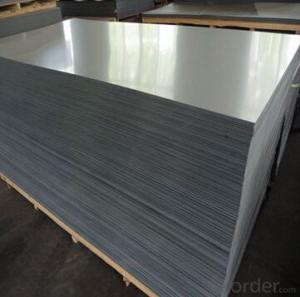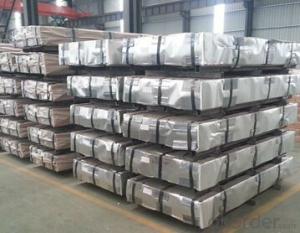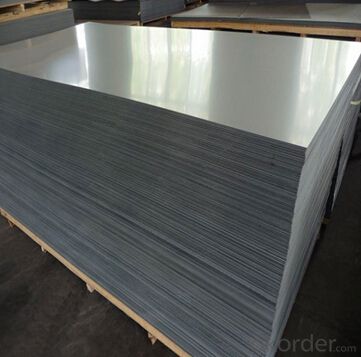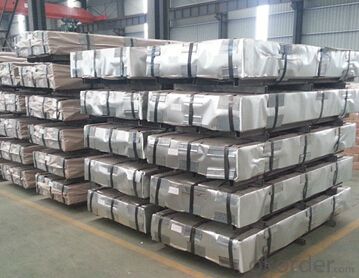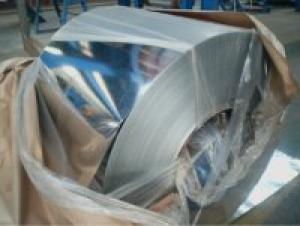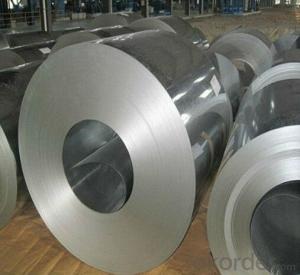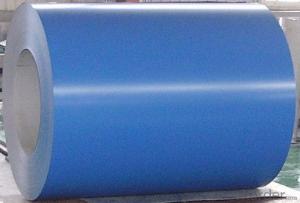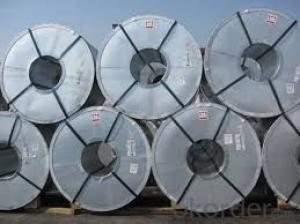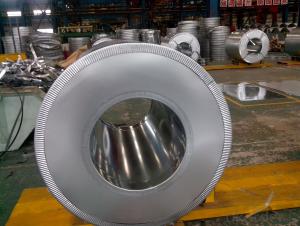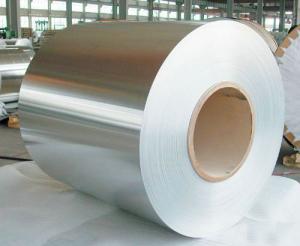Hot dipped Galvanized steel coil Z275 No spangle 0.15mm
- Loading Port:
- Tianjin
- Payment Terms:
- TT OR LC
- Min Order Qty:
- 25 m.t.
- Supply Capability:
- 10000 m.t./month
OKorder Service Pledge
OKorder Financial Service
You Might Also Like
Galvanized Steel Sheet
1.Thickness: 0.15mm - 3.5mm
2.Width: 600mm - 2000mm
3.Length: As you request
Specifications of Hot Dip Galvanized Steel Sheet/Plate:
1) Capacity: about 1,5000 tons per month for the steel sheet and coil product.
2) Grade: SGCC, DX51D, Q195, all according to the customer's request
3) Standard: JIS G3302 1998, ASTM A653M/A924M 2004, all according to the customer's request
4) Thickness: 0.15mm - 3.5mm, all available.
5) Width: 600mm - 2000mm , all available.
6) Length: we can adjust the length according to your request
7) Elongation: Min. 7%
8) Zinc coating weight: Min. 60gm/mm2, double side
9) Tensile strength: 28.1 - 49.2kgf/mm2
10) Spangle: regular spangle, minimized spangle and zero spangle
11) Surface treatment: chemical passivating treatment, oils, passivating oils, Anti-finger print;
12) Edge: mill edge, cut edge
13) Min trial order 25 ton each thickness, 1x20' per delivery;
Surface Finish of Hot Dip Galvanized Steel Sheet/Plate :
| Surface finish | Pattern | Application |
| Regular spangle | Standard spangles with flower pattern | General uses |
| Minimized spanlge | Minimized spangles than regular | General painting applications |
| Zero spangle | Extremely minimized spangles | Special painting applications |
Applications of Hot Dip Galvanized Steel Sheet/Plate:
1. Construction and building: roofings, ventilating duct; handrail; partition panel,etc.
2.Further processing: coating base plate.
3. Electric appliances: refrigerator; washing machine; recorder; microwave, etc.
Features of Hot Dip Galvanized Steel Sheet/Plate :
1) Hot Dip Galvanized Steel Sheet/plate is manufactured to have a long durability, strong corrosion resistance and shiny surface.
2) Hot Dip Galvanized steel features excellent forming properties, paintability, weldability, and is suitable for fabrication by forming, pressing and bending
- Q: What is the (balanced) chemical equation for steel?
- This Site Might Help You. RE: Chemical equation for steel? What is the (balanced) chemical equation for steel?
- Q: hello friends, I have some old 7.62x54r on stripper clips its nasty gunk on it can i use steel wool to glean it and still have it fire safely?
- * Yes, but I use both fine steel wool and Liquid Brasso Metal Polish on mine.* You can buy it at any Hardware and I believe Walmart carries it.* Great stuff.*
- Q: How are steel coils used in the production of electrical conduits?
- Steel coils are used in the production of electrical conduits as they serve as the raw material for manufacturing these conduits. The steel coils are processed and shaped into cylindrical tubes, which are then used to protect and enclose electrical wires, ensuring safe and efficient transmission of electricity.
- Q: How are steel coils used in the production of metal storage systems?
- Steel coils are typically used as a primary raw material in the production of metal storage systems. These coils are unrolled and processed through various machines and equipment to form different components such as shelves, frames, and supports. The steel coils are cut, shaped, welded, and coated to ensure durability and strength. Additionally, the coils can also be used to create interlocking panels or sheets that form the walls and roofs of the storage systems. Overall, steel coils play a crucial role in the manufacturing process, providing the necessary material for the construction and assembly of metal storage systems.
- Q: What is the most common bullet resistant steel that is used, can certain bullets just not be stopped, also what type of glass is bullet resistant or is that special made.
- The trauma plates in most vests are made from titanium steel. But the real issue is how thick a plate of a particular material must be to soak up the kinetic energy of a particular bullet. Certain bullets are a lot easier to stop than others. But, again, it's all about the bullet mass and velocity. Bulletproof glass is usually several layers of glass bonded together with a clear plastic film and it's generally special made. Doug
- Q: What are the different methods of levelling steel coils?
- Different methods are employed to level steel coils, depending on their specific requirements and applications. Some commonly used methods include: 1. Roller Leveling: This method utilizes a series of rollers to apply pressure on the steel coil, effectively reducing residual stresses and eliminating any waviness or curvature. It is commonly used for achieving high flatness in thinner gauge coils. 2. Stretch Leveling: In this method, the steel coil is stretched beyond its yield point to eliminate shape defects. The coil is subjected to tension in a stretcher leveler machine, which elongates the material and removes inherent stresses. It is often used for achieving greater flatness in thicker gauge coils. 3. Temper Milling: This method involves passing the steel coil through a temper mill equipped with work rolls on top and bottom. The temper mill applies tension to the coil, flattening it and improving its shape and surface quality. It is typically used for higher strength steel grades. 4. Corrective Leveling: When the steel coil exhibits significant shape defects like wavy edges or center buckles, corrective leveling is employed. This method selectively removes material from specific areas of the coil to achieve a flat and uniform surface. Laser or plasma cutting machines are often used for this process. 5. Tension Leveling: Similar to stretch leveling, tension leveling applies tension to the coil without exceeding its yield point. Bridle rolls are used to stretch the material, eliminating internal stresses and leveling the coil. It is commonly used for achieving flatness in higher strength and thinner gauge coils. These methods can be used individually or in combination, depending on the specific requirements and desired end product. Each method has its advantages and limitations, and the choice of leveling method depends on factors such as coil thickness, material properties, and desired flatness.
- Q: How are steel coils processed and shaped into different products?
- Different products are manufactured from steel coils through a series of manufacturing processes. The initial step is referred to as uncoiling, which entails the unwinding and straightening of the steel coil. Typically, this is achieved by feeding the coil through a machine called a decoiler. Once the coil is uncoiled, it proceeds to the leveling process. The objective of this step is to eliminate any unevenness or warping in the steel. The coil is passed through a set of rollers that exert pressure and flatten the steel to achieve the desired thickness. This ensures that the steel is uniform and prepared for further processing. Following the leveling process, the steel is usually cut into smaller pieces or sheets. Machines such as shears or slitters are employed for this purpose, enabling the steel to be cut into various widths or lengths. The specific dimensions depend on the requirements of the particular product being manufactured. After the steel is cut, it can undergo additional shaping processes. One commonly used method is roll forming, in which the steel is gradually shaped into the desired profile by passing it through a series of rollers. This technique is frequently utilized in the production of roofing sheets, wall panels, or beams. Another widely used shaping process is stamping. In stamping, the steel is pressed between a die and a punch to create intricate shapes or patterns. This method is commonly employed in the automotive industry for the production of components such as car body panels or engine parts. In addition to shaping, the steel may also undergo surface treatments or coatings to enhance its properties or improve its appearance. This can involve processes like galvanizing, where a layer of zinc is applied to safeguard the steel against corrosion, or painting to provide a decorative finish. In conclusion, the process of shaping steel coils into different products encompasses a combination of cutting, shaping, and surface treatments. These processes are meticulously executed to ensure that the steel meets the required specifications and is suitable for use in various industries.
- Q: Are steel coils susceptible to damage during storage or transportation?
- Yes, steel coils are susceptible to damage during storage or transportation. Factors such as mishandling, improper stacking, exposure to moisture or extreme temperatures, and inadequate packaging can lead to dents, scratches, corrosion, and even deformation of the coils. Adequate precautions and secure packaging are necessary to minimize the risk of damage during storage or transportation.
- Q: I have a set of steel pans with copper bottoms. When I cook with oil it always burns the oil to the pan and takes days to clean. I don't think I should use steel wool, since it might scratch the surface. Does anyone know a faster way to clean scorched oil off a steel pan?
- they have drywall (mudding) sponges to sand mud when you fix walls in the house, they are grey, square, and do not scratch. They seem to work better than any scrubber ever. Make sure you use a degreaser dishsoap like dawn. Maybe try putting your heat lower in the pan and cooking things more slowly?
- Q: Can steel coils be coated with barcodes?
- Yes, steel coils can be coated with barcodes.
Send your message to us
Hot dipped Galvanized steel coil Z275 No spangle 0.15mm
- Loading Port:
- Tianjin
- Payment Terms:
- TT OR LC
- Min Order Qty:
- 25 m.t.
- Supply Capability:
- 10000 m.t./month
OKorder Service Pledge
OKorder Financial Service
Similar products
Hot products
Hot Searches
Related keywords
